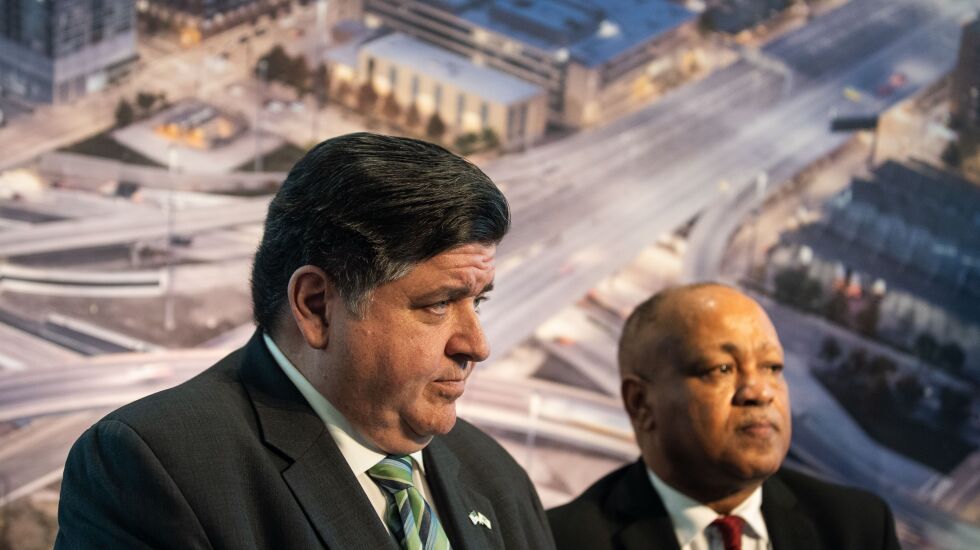
For millions of motorists, construction on the Jane Byrne Interchange came to seem like something you just lived with.
But with a ribbon-cutting held Wednesday, state officials announced that, after nearly 10 years of construction on the expressway spaghetti bowl just west of downtown, the project is “substantially complete” and is expected to reduce traffic congestion by 50%.
The reduced congestion is expected to save $185 million annually in lost productivity caused by delayed commuters.
The interchange accommodates 400,000 vehicles every day, about 25% of which are trucks.

“It’s been an awful long time in coming,” Gov. J.B. Pritzker said at a ribbon-cutting held at the National Hellenic Museum that sits just off the interchange in Greektown. “To say this project was a massive undertaking is truly the understatement of the century.”
P.S. Sriraj, director of the University of Illinois Chicago’s urban transportation center, said the project is “definitely a big shot in the arm for the region.”
But he questions whether the projected 50% reduction in delays will be realized due to two factors that engineers who came up with the number could never had predicted: the pandemic-related increase in freight delivery and a drop in public transportation.
“It’s unknown how those two things will play out. Only time will tell. I’m keeping my fingers crossed,” he said, noting meaningful test samples won’t be available for a few months.
Reconstruction of the interchange that connects the Dan Ryan, Kennedy and Eisenhower expressways began in 2013. It was originally slated for completion in 2018 but suffered a series of delays due to a variety of factors.
One of the biggest was a diversion of resources to address emergency fixes to bridges connecting Lake Shore Drive to the Stevenson Expressway. Another was poor soil conditions that required on-the-fly engineering solutions.
“Engineers were pushed to the max to fix an interchange that was this complicated without wholesale road closures, which would have been a disaster,” said transportation expert Joseph P. Schwieterman, who teaches at DePaul University.
In hindsight, more information could have been shared with a frustrated public about the project’s changing timeline, state Transportation Secretary Omer Osman said.
“Maybe we could have done a better job explaining it,” he said. “That is a lesson we have learned. Be upfront with the public. But we were so busy planning and designing as we go.”
Improvements include additional lanes in both directions on the three expressways that traverse the interchange and widening of the busiest ramps from one lane to two; 32 miles of reconstructed roadway; 19 reconstructed bridges; installation of 12 miles of storm sewers; a stormwater retention tank capable of holding more water than two Olympic-size swimming pools to alleviate flooding; 17.3 miles of new roadway lighting; and the construction of 50 retaining walls.
Construction of the original interchange began in the 1950s and was completed in 1962. The coil of roadways tucked into a small footprint just off the city center was not built to handle the country’s increased use of vehicles in the following decades.
The price tag of the current project ballooned from $535.5 million to $806 million. Federal funds paid for more than 90% of the project.
The overhaul of the interchange is expected to result in 25% fewer crashes, 1.6 million fewer gallons of gas being used each year, a 33% reduction of greenhouse gases emitted by cars that for years were stuck in traffic in what has perennially been ranked as one of the nation’s worst big-city bottlenecks.
Officials with the Illinois Department of Transportation, which led the project, said there is still work to do on several ramps, including ones leading from Jackson and Adams streets to the outbound Kennedy. Resurfacing of the roadway beneath Hubbard’s Cave is also yet to be done and will take place in the spring during overnight hours.
Also on the state’s punch list: Installing signs, bridge painting and finishing $10 million in landscaping.
The interchange is named for former Mayor Jane Byrne, who died in 2014.
On Wednesday, her daughter, Kathy Byrne, held up a necklace of her mother’s that contained the seal of the city and the words “One Chicago.”
“What the Jane Byrne Interchange does is it brings Chicago together,” she said. “I can’t thank you enough for allowing this to be named after my mom. Thank you.”
To view a livestream of the upgraded interchange, visit travelmidwest.com.







